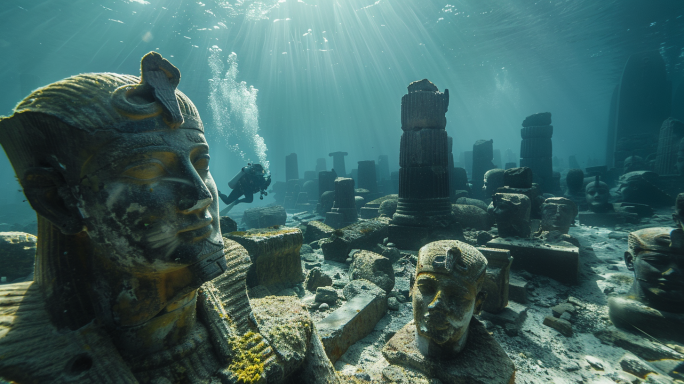Introduction
Thonis-Heracleion, an ancient Egyptian city that lay submerged beneath the Mediterranean Sea for over a thousand years, was rediscovered in 2000. Once a bustling trade hub and religious center, this city mysteriously sank into the waters off the coast of Alexandria. Excavations have revealed stunning artifacts, colossal statues, and temples, offering a glimpse into its glorious past. However, the exact cause of its submersion remains a subject of speculation.
The Discovery of Thonis-Heracleion
Initial Discovery
In 2000, a team of marine archaeologists led by Franck Goddio made a groundbreaking discovery off the coast of Alexandria. Using advanced sonar technology, they identified the remains of an ancient city submerged beneath the Mediterranean Sea. This city, known as Thonis-Heracleion, was a significant find, shedding light on a lost chapter of Egyptian history.
Excavation Efforts
Excavation efforts began soon after the discovery, revealing a wealth of artifacts and structures preserved underwater. These included colossal statues, stone slabs with inscriptions, coins, pottery, and the remains of grand temples. The meticulous underwater excavation provided a unique opportunity to study the city in its submerged state, offering valuable insights into its past.
Historical Significance
Ancient Trade Hub
Thonis-Heracleion was a major trade hub in ancient Egypt, strategically located at the mouth of the Nile River. It served as a vital port for the exchange of goods between Egypt and the Mediterranean world. The city’s prosperity was evident in the wealth of artifacts discovered, indicating a thriving economy based on trade.
Religious Center
In addition to its commercial significance, Thonis-Heracleion was also a prominent religious center. The city was home to the grand temple of Amun-Gereb, one of the most important deities in ancient Egypt. Pilgrims and traders alike visited the temple, contributing to the city’s status as a religious and cultural hub.
Archaeological Finds
Colossal Statues
One of the most remarkable discoveries in Thonis-Heracleion was the colossal statues that once adorned its temples and public spaces. These statues, some standing over five meters tall, depicted pharaohs, gods, and other significant figures. Their preservation underwater provided an unprecedented look at ancient Egyptian sculpture and artistry.
Inscriptions and Stone Slabs
Numerous stone slabs with inscriptions were also uncovered during the excavations. These inscriptions, written in both Egyptian and Greek, provided valuable information about the city’s history, religious practices, and political events. They also helped confirm the city’s identity and its dual names, Thonis and Heracleion, used by Egyptians and Greeks, respectively.
Coins and Pottery
The discovery of coins and pottery further highlighted Thonis-Heracleion’s role as a trade hub. The variety of coins found, originating from different regions of the Mediterranean, indicated the city’s extensive trade connections. Pottery fragments revealed insights into daily life, trade practices, and cultural exchanges between the city’s inhabitants and visitors.
Theories on Its Submersion
Natural Disasters
One prevailing theory suggests that a series of natural disasters led to the city’s submersion. Earthquakes and tidal waves, common in the region, could have caused significant damage to the city’s infrastructure, leading to its eventual collapse and sinking. The discovery of fault lines and evidence of seismic activity in the area supports this hypothesis.
Rising Sea Levels
Another theory points to rising sea levels as a contributing factor. Over time, the gradual increase in sea levels could have inundated the low-lying areas of Thonis-Heracleion, eventually submerging the entire city. Geological studies indicate that sea levels in the Mediterranean have risen significantly over the past millennia, lending credence to this theory.
Soil Liquefaction
Some researchers propose that soil liquefaction played a role in the city’s sinking. Soil liquefaction occurs when saturated soil loses its strength and stability due to sudden stress, such as an earthquake. This phenomenon could have caused the ground beneath Thonis-Heracleion to become unstable, leading to the city’s collapse and submersion.
The Mystery Endures
Ongoing Research
Despite the significant discoveries and extensive research, the exact cause of Thonis-Heracleion’s submersion remains uncertain. Ongoing archaeological and geological studies continue to explore the various theories, aiming to uncover more evidence and provide a definitive explanation for the city’s fate.
The Enigma of the Sunken City
The mystery of Thonis-Heracleion adds to its allure, captivating historians, archaeologists, and enthusiasts alike. The city’s rediscovery has sparked renewed interest in ancient Egypt’s maritime history and the potential for other undiscovered sites lying beneath the Mediterranean’s depths.
Conclusion
Thonis-Heracleion stands as a testament to the grandeur and mystery of ancient civilizations. Its rediscovery has provided a unique glimpse into the past, revealing a city that was once a thriving trade hub and religious center. While the exact cause of its submersion remains a subject of speculation, ongoing research continues to shed light on this fascinating chapter of history. The story of Thonis-Heracleion serves as a reminder of the enduring legacy of ancient Egypt and the mysteries that still lie hidden beneath the waves.
FAQs
1. What was Thonis-Heracleion?
Thonis-Heracleion was an ancient Egyptian city that served as a major trade hub and religious center. It was submerged beneath the Mediterranean Sea for over a thousand years before being rediscovered in 2000.
2. How was Thonis-Heracleion discovered?
The city was discovered in 2000 by a team of marine archaeologists led by Franck Goddio. They used advanced sonar technology to identify the submerged remains off the coast of Alexandria.
3. What significant artifacts were found in Thonis-Heracleion?
Excavations revealed a wealth of artifacts, including colossal statues, stone slabs with inscriptions, coins, pottery, and remains of grand temples. These finds provided valuable insights into the city’s history and culture.
4. What theories explain the submersion of Thonis-Heracleion?
Theories include natural disasters such as earthquakes and tidal waves, rising sea levels, and soil liquefaction. These factors could have contributed to the city’s collapse and eventual submersion.
5. Why is the cause of Thonis-Heracleion’s submersion still a mystery?
Despite extensive research, no definitive evidence has been found to confirm a single cause. Ongoing studies aim to uncover more information and provide a clearer explanation for the city’s fate.

